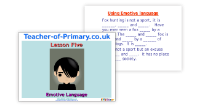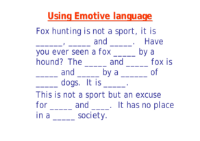Writing to Persuade - Lesson 5 - Emotive Language PowerPoint

English Resource Description
Lesson Five in the persuasive writing series hones in on the power of emotive language, a tool that can sway the reader's feelings and reinforce the writer's argument. The lesson's objective is to teach students how to effectively employ emotive language to bolster their persuasive writing. Emotive language is selected to elicit specific emotional responses such as sympathy, anger, or fear. For instance, describing someone's behaviour as 'appalling' and a person as 'fragile' can provoke a strong reaction, making the reader more receptive to the writer's viewpoint. The lesson encourages the use of potent adjectives, urging students to choose words that not only fit the context but also evoke a desired emotional response, such as 'vile', 'innocent', or 'lonely'.
During the lesson, students are challenged to infuse a text about fox hunting with adjectives to amplify its emotional impact, thus enhancing its persuasive power. They are guided to select words that paint a vivid and emotional picture of the scene. Following this, students engage in constructive criticism through speaking and listening exercises, where they read their paragraphs aloud, justify their choice of adjectives, and receive feedback on how to further improve the emotive appeal of their writing. The lesson also touches on flattery as another persuasive technique, illustrating how making the reader feel valued can be influential. Students are then tasked with applying all the techniques they've learned, such as using facts, opinions, emotive language, and flattery, to write a letter persuading an elderly relative to stop smoking, demonstrating the effectiveness of these devices in persuasion.

